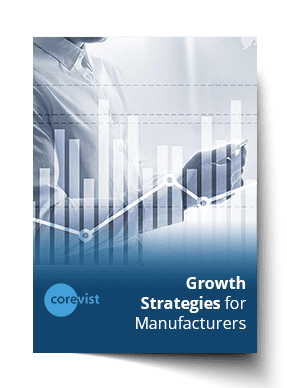Share
Author
George Anderson
Share
First published Aug 8, 2017. Refreshed Aug 25, 2021.
If you build B2B eCommerce, will they come?
Not necessarily.
In today’s digital-first world, just launching B2B eCommerce isn’t enough. You won’t start seeing ROI until you shift some portion of your sales to B2B eCommerce. You need to create B2B eCommerce experiences that offer real value to customers—then help them experience that value for themselves. It all starts with this awareness.
Luckily, building awareness (and turning it into B2B eCommerce adoption) is easier than you might think. In this article, we’ll talk about 8 steps you can take today to drive B2B eCommerce adoption.
Step 1: Define your business objective
It’s crucial to define your business objective. Why are you launching B2B eCommerce? Why are you seeking to onboard your customers?
It’s important to choose a goal that is specific, measurable, and attainable, and that dovetails with your other business objectives.
Organizations that come to us typically have one (or more) of these high-level goals for B2B eCommerce.
- Grow revenue
- Modernize customer experience to stay competitive in the digital age
- Increase operational efficiency
If you pursue one of these goals, the other two will usually follow—but most organizations can point to one or two that they value the most. Ideally, you’ll want to measure your adoption success not only with a B2B eCommerce adoption rate (e.g. 50% of customers now using eCommerce), but also with a metric that’s tied to one of these high-level goals.
Why?
Because if you’ve succeeded in onboarding lots of customers but failed at the high-level goal, something might be wrong. Imagine these scenarios.
- You’ve onboarded 90% of customers across a 3-month period, but B2B eCommerce revenue hasn’t grown across that period. What’s wrong with your B2B eCommerce experience?
- You’ve launched a great-looking B2B eCommerce experience, but only 5% of customers are using it. What’s getting in the way?
- You’ve onboarded 50% of customers, but they’ve got more questions than ever for customer service, and your cost of doing business is rising. What happened?
(By the way, in all these cases, the problem is most likely due to a lack of SAP ERP integration. Corevist Commerce Cloud solves that out of the box.)
This is why it’s important to define not only a percentage or number of customers onboarded, but also the business impact you hope to see from that onboarding. Both goals need a quantifiable metric so you can determine success.
Step 2: Define the marketing objective
Next, you need to define the marketing objective that supports the business objective. To increase B2B eCommerce adoption (and grow revenue, create a competitive experience, or increase efficiency), you need to drive customer awareness of the value of B2B eCommerce. This is especially true if you have a large percentage of people who aren’t using the site.
Here, if there are any sub-segments of the user base that you want to reach, it’s important to break them out and look at their needs individually. For example, if you’re trying to increase B2B eCommerce adoption across all the board, you should separate customers into segments. There are many ways to do this, such as geography, sales area, brand, or type of business that the customer represents.
You can also segment customers by their “B2B eCommerce temperature”—i.e., how much interest they’ve shown in using B2B eCommerce. You might break them out into buckets like these.
- Lukewarm: Customers who have received the email invitation to sign up, have registered, and have used the site under 5 times.
- Cold: Customers who have received the email invitation to sign up, have registered, and have used the site once (or have never even logged in).
- Unreached: Customers who haven’t received the email invitation and/or haven’t even heard about the eCommerce site.
Once you’ve segmented your customers based on their B2B eCommerce temperature, you should define a marketing objective that fits each bucket.
- Lukewarm and cold customers: Explain the benefits of eCommerce on a level that makes sense to the user and offer a new incentive for returning to the eCommerce site.
- Unreached: Introduce them to the new eCommerce site. Create a favorable first impression, and offer an incentive to use the site.
Step 3: Define strategies that support the marketing objective
Once you’ve defined the marketing objective for each segment, you can develop concrete strategies to reach those segments. With the right messaging, you can use each of these strategies for customers with any B2B eCommerce temperature.
Here are specific strategies you can use to reach your customer segments.
- Create an email nurture campaign to inactive users. Write a positive, approachable email that offers an incentive. Free shipping is the most popular incentive, but you can also offer a promotional product, a discount, or similar.
- Provide educational opportunities throughout the site so the customer sees the value in the site the moment they log in. You can use things like tool tips and walk-through guides to educate customers. These features are especially helpful for sophisticated functionality like cart management.
- Offer incentives for customers through your customer service reps (CSRs) to customers who haven’t adopted B2B eCommerce. Some people do best with person-to-person communication. Your CSRs offer you the opportunity to reach these customers with a personal touch and 1:1 assistance where necessary.
- Create a program that incentivizes sales reps to drive B2B eCommerce adoption. While B2B eCommerce might seem like a threat to sales reps, it’s actually a helpful tool for increasing their commission. It offers personalized product recommendations that reps can use to sell smarter—and with customers performing self-service order entry and tracking, B2B eCommerce relieves reps from tedious chores. The key here is to get your sales reps involved as early in the project as you can.
Step 4: Create content to support each strategy
Content will make or break your adoption strategies. You need to explain the benefits of B2B eCommerce, offer a real incentive, and hit the right tone.
Some segments will need content that is specifically tailored to their existing feelings about B2B eCommerce (i.e. whether they’re excited about it, lukewarm, or cold). Generalized content will work for other segments. For example:
- The user who has never logged into B2B eCommerce can receive a general email explaining the benefits that B2B eCommerce brings them (24x7x365 self service ordering, electronic payments, and more).
- The maintenance technician who orders replacement parts can receive a personalized email from a CSR. This email can explain how B2B eCommerce facilitates a personalized catalog of replacement parts related to the technician’s machines.
- The procurement manager who routinely reorders the same products can receive an email explaining how B2B eCommerce allows 1-click reordering through saved carts.
At this point, it’s good to introduce A/B testing. For each message flow you create, build two versions and vary the messaging. When you launch your campaign, you can track which version performs better.
Your content touchpoints should be educational. Here, it’s crucial to adopt the customer’s perspective. What benefit does B2B eCommerce offer—not to you, but to your customer? Sit at the customer’s desk and understand the struggles they face at work every day. How will the site make life better for them? If you can’t communicate those reasons to your customers, they won’t adopt B2B eCommerce.
Step 5: Launch your B2B eCommerce adoption drive
Once everything is in place—incentive, website content, automated email content, and any supporting blog posts—you can launch your adoption campaign.
It’s important to monitor both goals of your campaign—not only the raw B2B eCommerce adoption rate, but whatever high-level business metric aligns with your overarching goal (i.e. growing revenue, creating a competitive experience, or increasing efficiency).
At each stage, you’ll want to track the performance of the campaign with tools like these.
- Mailchimp (or similar email list tool), where you can track open rate and click-through rate.
- Analytics tools like Google Analytics or Fullstory, where you can track onsite behavior of customers.
- Your B2B eCommerce admin panel, where you can track customer signup and usage of B2B eCommerce.
Step 6: Adjust as necessary and repeat
You’ll notice patterns in the response to your campaign, as well as outliers. You’ll want to analyze the different types of responses that you see.
- Say a subset of users opened an email, but they didn’t click through to the site. Why not? Now you can A/B test with a follow-up message to this subset. Try one message with half of the group, and another message with the other half. Which message performs better? Use that message in the future for similar follow-ups.
- Say another subset of users never even opened the emails. What’s going on? Do we have the wrong email address? Have we targeted a person in the wrong department? It’s also possible that the person left the company.
- Some users may open the email, click through to the site, make a purchase, and come back less than 5 times. You can reach out to these users with a survey. Ask them why they didn’t use the site more often. Is the competition better? Are they used to using EDI? Do they prefer to call a salesperson? Their responses can give you the intelligence you need to serve them better through B2B eCommerce.
Step 7: Put a limit on the number of automated contacts
It’s an exception to the rule, but sometimes, a valid user simply doesn’t respond to any automated contacts. Now you have to get personal. You need to pick up the phone and inquire. If they’re not even opening the emails, there must be something going on. Your customer will appreciate the personal touch, and you’ll learn valuable information on individual responses to your B2B eCommerce launch.
It’s important to have these touchpoints with your customers, especially when you’re launching a new B2B eCommerce experience. You want to do as much as possible to alleviate pain points and assure your customers that B2B eCommerce will only make their lives easier.
Step 8: Measure results against objectives
Once the timed duration of your adoption drive has expired, it’s time to circle back and compare your results to your goals. Did you hit your goal? If so, celebrate. If not, figure out how to adjust, move forward, and launch a more effective campaign.
For example:
- If you didn’t reach your goals in a general adoption campaign, look at email opens and B2B eCommerce logins. Break things out into customer segments. Did your general message perform well with some segments, but not with others? In future campaigns, you can use more targeted messaging that addresses the concerns of each segment individually.
- If you didn’t reach your goals in a targeted adoption campaign, what went wrong? Analyze your open rate and adoption rate among the segment. Look at the different messages which you used in A/B testing. Reach out to key influencers in the segment and ask for personal feedback. You might be surprised at what you find out.
The Takeaway
A successful B2B eCommerce adoption campaign isn’t a black box. With understanding of your customer segments, great content, real incentives, and personal contact, you can meet your goals in shifting sales to eCommerce. At Corevist, we regularly advise our clients on how to achieve this. If you have any questions on the topic, don’t hesitate to get in touch.
NEW Report:
Growth Strategies for Manufacturers
Every manufacturer needs to grow in the digital age. Here’s the ultimate guide to growth strategies for manufacturers. Read now.










